Datum: 09-06-2015
With the Tour de France coming to Utrecht this summer, one is prone to think of racing bikes. But racing bikes are, of course, not what the overwhelming populace of the city ride. Many Utrechters cycle on old, rusting bikes that are in need of repair. And when many of these repairs eventually occur, oftentimes Utrechters use non-traditional methods.
Take, for example, replacing a rear fender.
Tekst: Pete Jordan
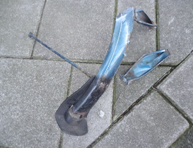
When a rear fender meets its demise and departs from a bike, the Utrecht cyclist is then left with a stream of water spraying up from wet roadways onto their asses.
No one likes having a wet ass. But what to do? In response, the cyclists of Utrecht follow through an ever evolving progression in their attempt to improvise a rear fender on their bikes.
Stage 1: The cyclist who suddenly finds himself without a rear fender just grabs whatever is handy—a piece of cardboard—and shoves it into the rear rack to serve as an impromptu fender.
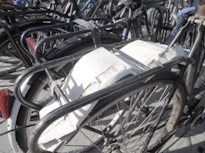
Stage 2: A piece of cardboard just shoved into the rear rack isn’t secure enough, though, so the cyclist wraps tape around it.

Stage 3: An even more secure method is by using rip-ties.
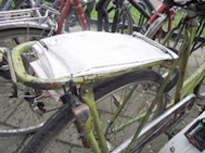
Stage 4: But ultimately cardboard isn’t a good material to use as protection against rainwater. So the cyclist graduates to plastic. An old Jumbo supermarket shopping bag will do.
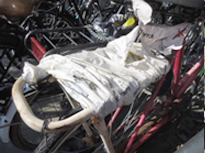
Stage 5: While an ratty old Jumbo bag is ok, a newer bag is better.

Stage 6: Better still is straightening and smoothing out the Jumbo bag.
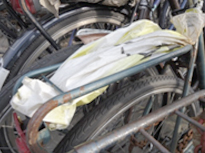
Stage 7: But the bag needs to be secured, so the cyclist employs the snelbinder.
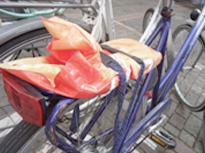
Stage 8: To make the bag ever more secure, the cyclist switches to using rip-ties.
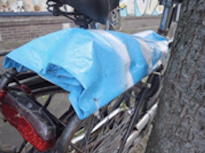
Stage 9: Tape! Strapping down the shopping bag with tape is even better.
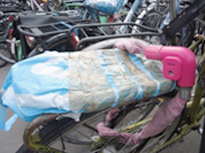
Stage 10: And the more tape the better!
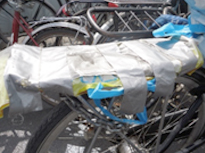
Stage 11: But then there comes a point when the cyclist is using so much tape to secure the shopping bag that the bag itself becomes superfluous. Better to just cut out the shopping bag all together and just use a whole lot of tape.
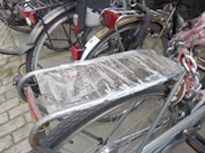
Stage 12: But this type of plastic tape isn’t strong enough.
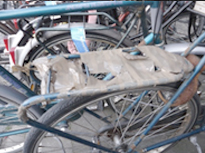
Stage 13: Better to use some nice strong duct tape!
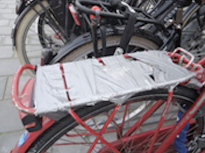
Stage 14: And if duct tape is to be employed, the cyclist eventually realizes it’s best to completely engulf the rear rack with it.
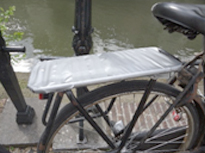
And there you have it. The Utrecht cyclist without a rear rack who doesn’t like getting his or her ass wet in the rain starts off by shoving a piece of cardboard in his or her rear rack and then eventually—more than a dozen stages later—graduates to completely wrapping the rear rack in duct tape.
Then the cyclist proudly parks the bike along the Oude Gracht to let his fellow Utrechters see how far he has evolved in improvising a rear fender for his bike.
Toen schrijver Pete Jordan (1966) vanuit San Francisco naar Amsterdam verhuisde, liep hij meteen tegen de Nederlandse fietscultuur aan, letterlijk: al bij zijn eerste stappen in de stad reed een van de vele fanatieke fietsers hem omver. Hij raakte gefascineerd door de eindeloze stoet tweewielers in de stad en besloot een diepe duik te nemen in de historie van deze oer-Hollandse gewoonte. Zijn ervaringen als buitenlandse fietser in Nederland verzamelde Jordan in het boek De fietsrepubliek. Van de zwangere vrouwen tot fietsende nonnen, van de handelaren in gestolen fietsen tot de fietsenvissers die fietsen uit de grachten halen. Het resultaat is een unieke blik op een voor ons zo alledaagse bezigheid.
